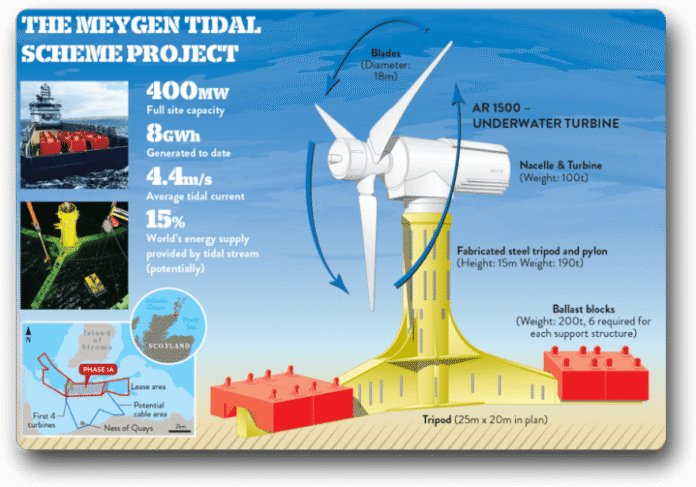Guest Post by Willis Eschenbach
Let me invite you to consider the Scottish coast, where the tides are large and the headlines are gushing—much like the capital outflow—over the MeyGen tidal project, a four-turbine, six-megawatt marvel whirring away beneath the waves. The headlines scream Underwater turbine spinning for 6 years off Scotland’s coast is a breakthrough for tidal energy.
Me? I’m just a suspicious sort with too many years in the accounting trenches and a soft spot for arithmetic. So I thought I’d take a peek at the math behind the green curtain and see what’s really going on.

First, the basics. The capital cost for the four-turbine Phase 1A MeyGen project was £51 million at construction—call it £66 million in 2025 pounds, or about US$90 million at today’s exchange rate. No one seems keen to publish the total operation and maintenance (O&M) bill for Maygen, but industry estimates for similar tidal setups run 2–4 cents per kilowatt-hour (kWh). For 51 million kWh generated so far, that’s a ballpark $1–2 million for O&M.
So, $91 million spent, 51 million kWh produced. That’s $1.78 per kWh—over thirty times the US grid price for gas-fired power, which hovers around $0.04–0.06 per kWh. Ouch.
Now I can hear you thinking, “But that’s just the first seven years! The costs are front-loaded! Surely it gets better over time?” And you’re right. So let’s squint into the always-misty future.
Over the projected 25-year lifespan of the four turbines, the array is expected to generate about 164 million kWh. There’ll be two major overhauls—$3 million each—and 25 years of O&M at around $0.03 per kWh, totaling around $6 million. Add it all up: $90 million (capital) + $6 million (overhauls) + $6 million (O&M) = roughly $102 million.
Divide by the lifetime output, and you’re looking at a cool US$0.62 per kWh. That’s about ten times what gas power costs in the US.
Why are the costs so high? Well, in part it’s the “capacity factor”. That’s the percentage of the nameplate rating that they are actually generating. The individual turbines are rated at 1.5 megawatts. One has been operational for nine years, one for eight years, and two for 7 years. That’s 31 turbine-years, times 1.5 megawatts/turbine, times 8,766 hours per year, yields 407 gigawatt-hours (GWh) if they were running full-tilt.
But in the real world, they only put out 51 GWh, so their capacity factor is a pathetic 13% …
And that cost and capacity factor are assuming that there are no unexpected breakdowns in the next 18 years. Is that realistic, given that the ocean is one of the most corrosive natural environments on the planet.?
Well, a popular saying of my youth had it that “What goes around, comes around.”
But as a lifetime blue-water sailor, surfer, sport and commercial diver, and commercial fisherman, I can assure you that when the ocean is involved, the true saying is:
What goes around …
…
… stops.
And not only is the cost ludicrously high, but the output varies widely. There are two high and two low tides each day. So every 6 hours or so, at slack tides these megabuck machines are putting out exactly zero watts. That’s the reason for the low capacity factor. As a result, they require natural-gas-powered backup to balance them out by providing power for the four times daily when they wimp out.
And here’s where it gets truly Scottish, in the tragic sense of the Scottish Play. Scotland sits atop trillions of cubic feet of natural gas, but drilling for gas is banned in the name of meaningless virtue signaling.
The truth is that instead of tapping their own gas resources, the Scots import about 4 billion cubic meters of gas every year. They’re paying premium prices plus shipping costs for the same amount of gas, and they’re making zero difference to the amount of gas burned. It’s merely virtue signalling because they’re just burning Norwegian gas instead of Scottish gas. The only real gusher in Scotland these days is the steady stream of cash leaving the country.
How can the people pushing this madness think it’s a great plan? Don’t they own a calculator? I feel like the doctor in the Scottish Play when the Queen went mad, who said “This is a disease beyond my practice” …
And here at the end of the story, my question is … how did the Scots ever get a reputation for being financially canny and tight with a pound?
My best to all, even those mistakenly pushing Net Zero and the Green Nude Eel,
w.
You know the drill. When you comment, quote the exact words you are discussing. Makes things far clearer.
References: [1] [2] [3] [4] [5] [6] [7] [8]
Related
Discover more from Watts Up With That?
Subscribe to get the latest posts sent to your email.
